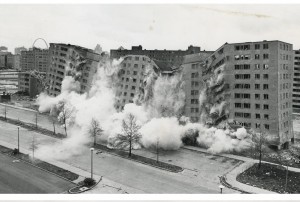Pinky says: What Goes Around Comes Around?
Sixty years ago there was a cry for urban housing for people who lived in squalid conditions in the center city of St. Louis, the city in which I grew up. A housing project based on the Modernist concepts of the French architect Le Courbusier was the answer that thrilled and excited the people of the city. It was designed by a classmate of mine at Washington University who was a partner in Helmuth Obata and Minoru Yamasaki who later designed the twin towers of the World Trade Center. St. Louis would become Manhattan on the Mississippi. And so in the years of the early 1950s the design which was redesigned many times arose. This was to be a solution to all of the overcrowding of urban dwellers, a high rise that cut costs and simultaneously allowed each tenant clean, livable, and new quarters. The reality was almost instantly recognized despite the architects and builders earnest hopes and dreams. Upon completion Pruitt-Igoe had 2000 dwelling units in 33 11 story buildings whose 10,000 people were stacked into an environment of despair. It was a federally built and supported slum in which only blacks lived because whites refused to live in the units after desegregation became the law of the land. Never more than 60% occupied, it became a mini city that possessed all the problems and difficulties that arise from race and poverty and all the impotence, indifference and hostility with which our society dealt with these problems at that time. To save building costs the elevators stopped only on the first, fourth, seventh, and tenth floors of each building. Stairwells used to reach the other floors reeked of urine; thugs and thieves lying in wait for tenants to use them. Children were exposed to crime and drug use as well as rodents and roaches. Children fell out of windows. And in less than 20 years the decision was made that Pruitt-Igoe was a drastic failure. I remember watching the first 3 buildings implode.
There was a similar failure in Chicago with Cabrini Green, another housing facility of high rise buildings designed to accommodate 15,000 people. It too was to designed as an ideal affordable Modernist approach to urban living. Gang wars and murders were so prevalent that the Mayor Jane Byrne made a valiant effort to live there in the 1980s to prove that it was a safe place for tenants. She was protected by police guards 24/7 and a steel door was installed at the back entrance to her apartment. She lasted 3 weeks. The difference in the two housing projects is that Cabrini Green lies on valuable land on the near North side of Chicago which is in demand for gentrification. The people who own property surrounding Cabrini Green estimate that the value of their homes and apartments increases at the rate of $35,000.00 each time another of the high rises is imploded.
It would seem that these two projects live on symbolically as icons of failure. Architectural critics deem it proof of the failure of high rise public housing for families. Liberals perceive it as an example of government’s appalling treatment of the poor. But hope springs eternal among architects and city planners. Teachers Village in Newark New Jersey is being designed and planned by Richard Meier as a complex for middle and lower income tenants. Meier is famous as the designer of white domiciles for the rich and international art museums. Teachers Village returns architecture and Meier to designing for other segments of society than the wealthy. It is a signal that after more than sixty years of frightening and devastating failures in architecture for the poor there just might be hope that creative energy in this area will be part of an overall effort to provide decent housing for the poor and the less affluent. And it may return architects to a commitment to elevate the lives of ordinary people. It may not be as ambitious as the federally funded ghettos built in the 1950s and 1970s but there is a refreshing involvement with solving the failures of the Modernist movement that created debacles like Pruitt-Igoe and Cabrini Green. The building surge of the 1990s and 2000s concerned itself solely with corporate towers and cultural institutions, witness the Gehry project in Bilbao, the Nelson Gallery addition by Holl. With Teachers Village there is a mix of condos and low and middle income housing anchored by two charter school buildings which are staffed by teachers living in apartment buildings that range in size from 17 to 66 units. There is space for the 1000 charter school teachers and also for another 5000 teachers in public schools. The design incorporates some of the sensibilities that are typical of Meier’s high end projects. There are small open courtyards and outdoor terraces which allow natural light into the apartments. There is already a preliminary design for a second phase of development with 15 additional apartment buildings which would extend the project several blocks further out in the area so that this could become a larger critical mass which could turn the area around. If this project succeeds in bringing life to Newark’s depressing downtown, if it manages to survive the decay around it, who knows what wonders may begin to flower. It does not have federal funding in the mix as did the projects before them. Perhaps this is the kind of project that can succeed. Architecture has always been dependent on the dictates of their clients and the financial feasibility of the project. Teachers Village has the support of all those involved, the city, the financiers, the architects. Said Meier, “You always hope what you build has arms, that they reach out and affect others. You want to feel you’ve done something that allows other positive things to happen.” Let’s hear it for the architects and builders willing to try to build urban housing for all classes of people!



Leave a Reply